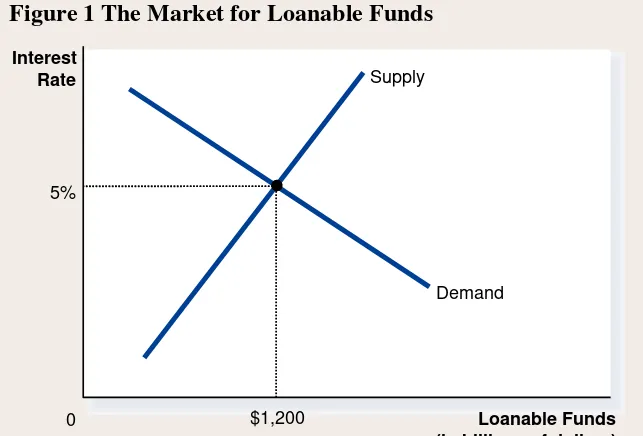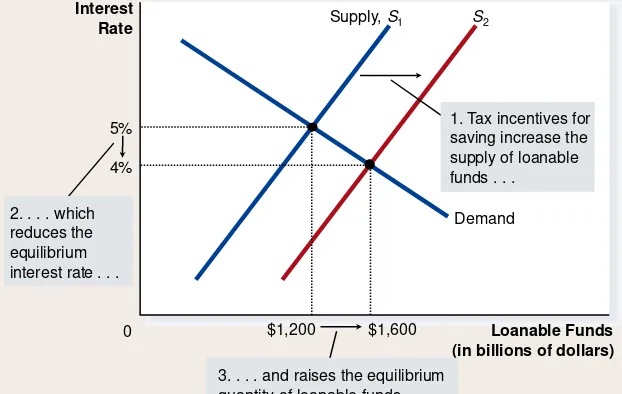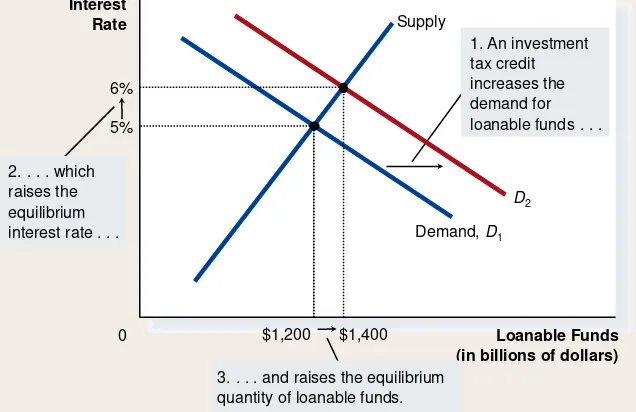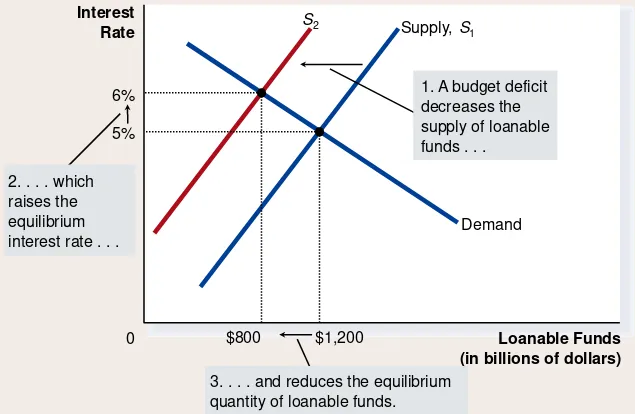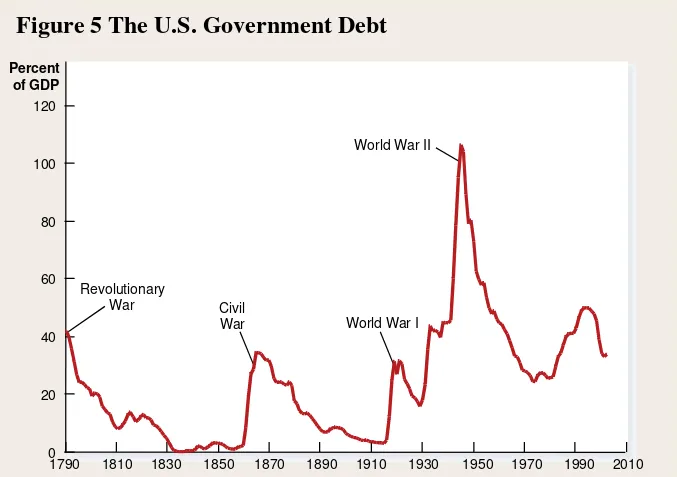© 2007 Thomson South-Western
Saving, Investment, and the Financial
System
• The financial system consists of the group of institutions in the economy that help to match
one person’s saving with another person’s
investment.
• It moves the economy’s scarce resources from
© 2007 Thomson South-Western
FINANCIAL INSTITUTIONS IN
THE U.S. ECONOMY
• The financial system is made up of financial
institutions that coordinate the actions of savers and borrowers.
• Financial institutions can be grouped into two
different categories:
– Financial markets
© 2007 Thomson South-Western
FINANCIAL INSTITUTIONS IN
THE U.S. ECONOMY
• Financial Markets
– Stock Market
– Bond Market
• Financial Intermediaries
– Banks
© 2007 Thomson South-Western
FINANCIAL INSTITUTIONS IN
THE U.S. ECONOMY
• Financial markets are the institutions through which savers can directly provide funds to
borrowers.
© 2007 Thomson South-Western
Financial Markets
• The Bond Market
• A bond is a certificate of indebtedness that specifies obligations of the borrower to the holder of the
bond.
• Characteristics of a Bond
• Term: The length of time until the bond matures.
• Credit Risk: The probability that the borrower will fail to pay some of the interest or principal.
• Tax Treatment: The way in which the tax laws treat the interest on the bond.
© 2007 Thomson South-Western
Financial Markets
• The Stock Market
• Stock represents a claim to partial ownership in a firm and is therefore, a claim to the profits that the firm makes.
• The sale of stock to raise money is called equity financing.
• Compared to bonds, stocks offer both higher risk and potentially higher returns.
• The most important stock exchanges in the United States are the New York Stock Exchange, the
© 2007 Thomson South-Western
Financial Markets
• The Stock Market
• Most newspaper stock tables provide the following information:
• Price (of a share)
• Volume (number of shares sold)
• Dividend (profits paid to stockholders)
© 2007 Thomson South-Western
Financial Intermediaries
• Financial intermediaries are financial
© 2007 Thomson South-Western
Financial Intermediaries
• Banks…
• take deposits from people who want to save and use the deposits to make loans to people who want to borrow.
© 2007 Thomson South-Western
Financial Intermediaries
• Banks…
• help create a medium of exchange by allowing people to write checks against their deposits.
• A medium of exchange is an item that people can easily use to engage in transactions.
© 2007 Thomson South-Western
Financial Intermediaries
• Mutual Funds
• A mutual fund is an institution that sells shares to the public and uses the proceeds to buy a portfolio, of various types of stocks, bonds, or both.
• Mutual funds allow people with small amounts of
© 2007 Thomson South-Western
Financial Intermediaries
• Other Financial Institutions
• Credit unions
• Pension funds
• Insurance companies
© 2007 Thomson South-Western
SAVING AND INVESTMENT IN THE
NATIONAL INCOME ACCOUNTS
• Recall that GDP is both total income in an
economy and total expenditure on the
economy’s output of goods and services:
© 2007 Thomson South-Western
Some Important Identities
• Assume a closed economy – one that does not
engage in international trade:
© 2007 Thomson South-Western
Some Important Identities
• Now, subtract C and G from both sides of the
equation:
Y – C – G = I
• The left side of the equation is the total income
in the economy after paying for consumption and government purchases and is called
© 2007 Thomson South-Western
Some Important Identities
• Substituting S for Y – C – G, the equation can
be written as:
© 2007 Thomson South-Western
Some Important Identities
• National saving, or saving, is equal to:
S = I
S = Y – C – G
© 2007 Thomson South-Western
The Meaning of Saving and Investment
• National Saving
• National saving is the total income in the economy that remains after paying for consumption and
government purchases.
• Private Saving
• Private saving is the amount of income that
households have left after paying their taxes and paying for their consumption.
© 2007 Thomson South-Western
The Meaning of Saving and Investment
• Public Saving
• Public saving is the amount of tax revenue that the government has left after paying for its spending.
© 2007 Thomson South-Western
The Meaning of Saving and Investment
• Surplus and Deficit
• If T > G, the government runs a budget surplus
because it receives more money than it spends. • The surplus of T - G represents public saving.
• If G > T, the government runs a budget deficit
© 2007 Thomson South-Western
The Meaning of Saving and Investment
• For the economy as a whole, saving must be
equal to investment.
© 2007 Thomson South-Western
THE MARKET FOR LOANABLE
FUNDS
• Financial markets coordinate the economy’s
saving and investment in the market for
loanable funds.
• The market for loanable funds is the market in
which those who want to save supply funds
© 2007 Thomson South-Western
Supply and Demand for Loanable Funds
• Loanable funds refers to all income that people
have chosen to save and lend out, rather than use for their own consumption.
• The supply of loanable funds comes from
people who have extra income they want to
save and lend out.
• The demand for loanable funds comes from
© 2007 Thomson South-Western
Supply and Demand for Loanable Funds
• Interest rate
• the price of the loan
• the amount that borrowers pay for loans and the amount that lenders receive on their saving
© 2007 Thomson South-Western
Supply and Demand for Loanable Funds
• Financial markets work much like other
markets in the economy.
• The equilibrium of the supply and demand for
© 2007 Thomson South-Western
Figure 1 The Market for Loanable Funds
Loanable Funds (in billions of dollars)
0
Interest
Rate Supply
Demand 5%
© 2007 Thomson South-Western
Supply and Demand for Loanable Funds
• Government Policies That Affect Saving and
Investment
• Taxes and saving
• Taxes and investment
© 2007 Thomson South-Western
Policy 1: Saving Incentives
• Taxes on interest income substantially reduce
the future payoff from current saving and, as a result, reduce the incentive to save.
• A tax decrease increases the incentive for
households to save at any given interest rate.
• The supply of loanable funds curve shifts right.
• The equilibrium interest rate decreases.
© 2007 Thomson South-Western
Figure 2 An Increase in the Supply of Loanable Funds
Loanable Funds (in billions of dollars)
0 quantity of loanable funds.
Demand
1. Tax incentives for saving increase the supply of loanable funds . . .
5%
$1,200 4%
© 2007 Thomson South-Western
Policy 1: Saving Incentives
• If a change in tax law encourages greater
© 2007 Thomson South-Western
Policy 2: Investment Incentives
• An investment tax credit increases the incentive
to borrow.
• Increases the demand for loanable funds.
• Shifts the demand curve to the right.
• Results in a higher interest rate and a greater
© 2007 Thomson South-Western
Policy 2: Investment Incentives
• If a change in tax laws encourages greater
© 2007 Thomson South-Western
Figure 3 Investment Incentives Increase the Demand for Loanable Funds
Loanable Funds (in billions of dollars)
0
Interest Rate
1. An investment tax credit
increases the demand for
loanable funds . . . quantity of loanable funds.
© 2007 Thomson South-Western
Policy 3: Government Budget Deficits and Surpluses
• When the government spends more than it
receives in tax revenues, the short fall is called the budget deficit.
• The accumulation of past budget deficits is
© 2007 Thomson South-Western
Policy 3: Government Budget Deficits and Surpluses
• Government borrowing to finance its budget
deficit reduces the supply of loanable funds available to finance investment by households and firms.
• This fall in investment is referred to as
crowding out.
© 2007 Thomson South-Western
Policy 3: Government Budget Deficits and Surpluses
• A budget deficit decreases the supply of
loanable funds.
• Shifts the supply curve to the left.
• Increases the equilibrium interest rate.
• Reduces the equilibrium quantity of loanable
© 2007 Thomson South-Western
Figure 4: The Effect of a Government Budget Deficit
Loanable Funds (in billions of dollars)
0
Interest Rate
3. . . . and reduces the equilibrium quantity of loanable funds.
S
6% 1. A budget deficit
© 2007 Thomson South-Western
Policy 3: Government Budget Deficits and Surpluses
• When government reduces national saving by
running a deficit, the interest rate rises and investment falls.
• A budget surplus increases the supply of
loanable funds, reduces the interest rate, and
© 2007 Thomson South-Western
Figure 5 The U.S. Government Debt
Summary
© 2007 Thomson South-Western
• The U.S. financial system is made up of
financial institutions such as the bond market, the stock market, banks, and mutual funds.
• All these institutions act to direct the resources
Summary
© 2007 Thomson South-Western
• National income accounting identities reveal
some important relationships among macroeconomic variables.
• In particular, in a closed economy, national
saving must equal investment.
• Financial institutions attempt to match one
person’s saving with another person’s
Summary
© 2007 Thomson South-Western
• The interest rate is determined by the supply
and demand for loanable funds.
• The supply of loanable funds comes from
households who want to save some of their income.
• The demand for loanable funds comes from
Summary
© 2007 Thomson South-Western
• National saving equals private saving plus
public saving.
• A government budget deficit represents
negative public saving and, therefore, reduces national saving and the supply of loanable
funds.
• When a government budget deficit crowds out
